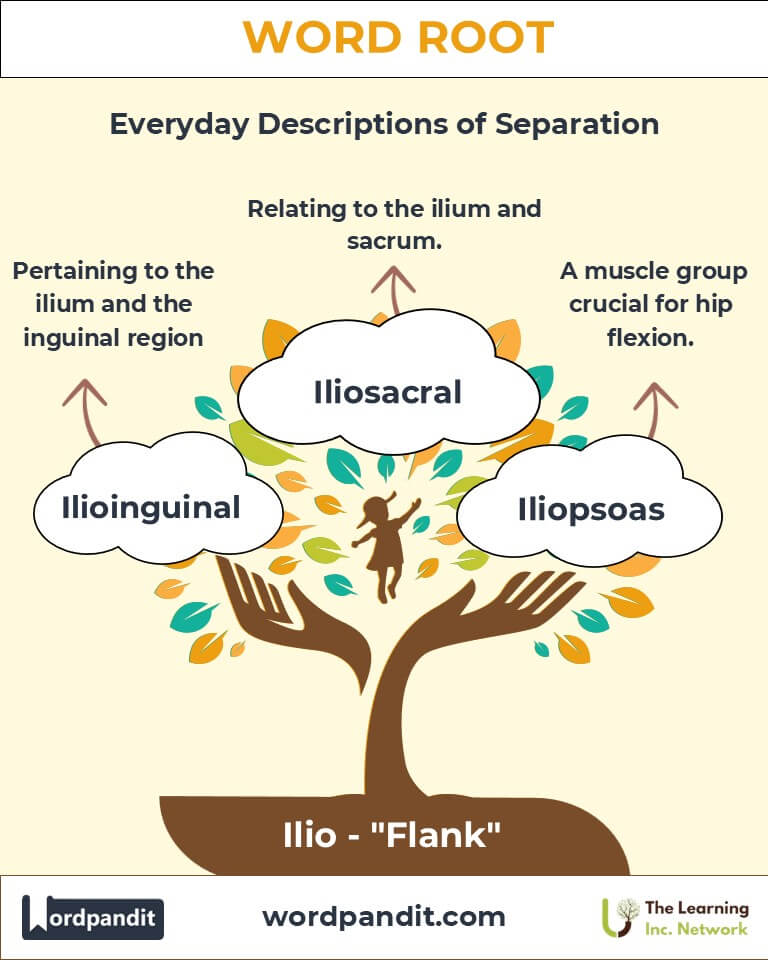Ilio: The Root of Strength and Structure in Anatomy
Discover the foundational power of the root "ilio," derived from Latin, meaning "flank." From anatomical terms like "ilium" to specialized medical concepts like "iliofemoral," this root underpins our understanding of key skeletal and muscular structures.

Table of Contents
- Introduction: The Essence of Ilio
- Etymology and Historical Journey
- Mnemonic: Unlocking the Power of Ilio
- Common Ilio-Related Terms
- Ilio Through Time
- Ilio in Specialized Fields
- Illustrative Story: Ilio in Action
- Cultural Significance of the Ilio Root
- The Ilio Family Tree
- FAQs about the Ilio Word Root
- Test Your Knowledge: Ilio Mastery Quiz
- Conclusion: The Living Legacy of Ilio
Introduction: The Essence of Ilio
Have you ever considered how the human body remains upright and mobile? Much of this stability can be traced back to the "ilio" root, a cornerstone of anatomical language. Derived from the Latin word for "flank," "ilio" forms the basis of words related to the pelvic region, such as ilium (a key bone in the pelvis) and iliofemoral (connecting the ilium to the femur). Its importance spans medicine, biology, and kinesiology, offering insights into how our bodies function and move.
Etymology and Historical Journey
The root "ilio" originates from the Latin word ilium, meaning "groin" or "flank." First used in classical anatomy texts, it described the broad, wing-like portion of the pelvic bone. As medical knowledge expanded during the Renaissance, "ilio" terms proliferated, appearing in works by luminaries like Andreas Vesalius. The root’s consistent use underscores its enduring relevance in anatomical study.
Mnemonic: Unlocking the Power of Ilio
To remember "ilio," imagine a strong, wing-like bone supporting the body’s structure, much like the ilium in the pelvis.
Mnemonic: "Ilio links structure and strength—holding the body’s balance together."
Common Ilio-Related Terms
- Ilium (il-ee-um): The uppermost and largest part of the pelvic bone.
Example: "The ilium provides attachment points for key muscles of the hip." - Iliofemoral (il-ee-oh-fem-er-uhl): Relating to the ilium and the femur, often referencing the iliofemoral ligament.
Example: "The iliofemoral ligament is critical for stabilizing the hip joint." - Iliocostalis (il-ee-oh-kos-tal-is): A muscle of the back extending from the ilium to the ribs.
Example: "The iliocostalis muscle helps maintain posture." - Iliopsoas (il-ee-oh-so-as): A muscle group that includes the iliacus and psoas major, key in hip flexion.
Example: "Tight iliopsoas muscles can cause lower back pain." - Ilioinguinal (il-ee-oh-ing-gwin-al): Pertaining to the ilium and the inguinal region.
Example: "The ilioinguinal nerve supplies sensation to the upper thigh."
Ilio Through Time
- Ilium in Ancient Texts: Classical anatomists recognized the ilium as a major skeletal component of the pelvis, essential for upright posture and movement.
- Iliofemoral in Modern Medicine: Advances in orthopedics have highlighted the importance of the iliofemoral ligament in hip replacements and joint stabilization.
Ilio in Specialized Fields
- Orthopedics: The iliac crest is used for bone grafts, essential in surgeries requiring structural bone repair.
- Physical Therapy: Iliopsoas stretches are common for alleviating hip and lower back pain, enhancing flexibility, and reducing injury risk.
- Radiology: Imaging of the iliac artery is vital for diagnosing pelvic vascular issues and detecting aneurysms or blockages.
Illustrative Story: Ilio in Action
Dr. Elena was examining a patient recovering from a fractured ilium after a car accident. She emphasized strengthening the iliofemoral ligament and iliopsoas muscles to restore mobility. Over months of physical therapy, the patient regained their ability to walk without pain, showcasing how "ilio" structures underpin human resilience and recovery.
Cultural Significance of the Ilio Root
The pelvis, with its connection to "ilio," has long been seen as a symbol of strength and fertility in art and culture. Ancient sculptures often highlighted the pelvis to represent vitality and life, emphasizing its centrality to the human form.
The Ilio Family Tree
- Pelv- (Latin: Pelvis):
- Pelvic girdle: Refers to the basin-like structure of the hips.
- Cox- (Latin: Hip):
- Coxal bone: Relating to the hip joint.
- Fem- (Latin: Thigh):
- Femur: Refers to the thigh bone, connecting to the ilium via the iliofemoral ligament.
FAQs About the Ilio Root
Q: What does "ilio" mean, and where does it originate?
A: "Ilio" comes from the Latin word ilium, meaning "flank" or "groin." It specifically refers to the ilium, the broad, wing-shaped bone forming the upper part of the pelvis. This root highlights the anatomical importance of the pelvis and its role in movement and stability.
Q: What is the ilium, and why is it important?
A: The ilium is the largest and uppermost part of the pelvic bone. It provides attachment points for several important muscles, including those involved in walking, standing, and maintaining posture. It also houses the iliac crest, a critical site for bone marrow harvesting and anatomical landmarks used in medical procedures.
Q: What does "iliofemoral" describe, and where is it found?
A: "Iliofemoral" refers to the connection between the ilium (pelvic bone) and the femur (thigh bone). The iliofemoral ligament is a Y-shaped structure that stabilizes the hip joint and prevents hyperextension during movement, ensuring proper alignment and function of the lower body.
Q: What is the function of the iliopsoas, and why is it significant?
A: The iliopsoas is a muscle group consisting of the iliacus and psoas major. It is one of the primary hip flexors, essential for activities like walking, running, and climbing stairs. Tightness or weakness in the iliopsoas can lead to lower back pain or hip dysfunction, making it a key focus in physical therapy and exercise.
Q: What role does the iliac crest play in the body?
A: The iliac crest forms the upper border of the ilium and serves as an attachment point for abdominal and back muscles. It is an easily palpable landmark used by healthcare professionals for procedures like lumbar punctures and bone grafts.
Test Your Knowledge: Ilio Mastery Quiz
1. What does the root "ilio" mean?
2. Which bone is associated with "ilio"?
3. What is the function of the iliofemoral ligament?
4. What muscle group includes the iliacus?
5. Where is the iliac crest located?
Conclusion: The Living Legacy of Ilio
The root "ilio" highlights the intricate connections within the human body, from the pelvic bones to the muscles and ligaments that enable movement. Its importance spans medical, cultural, and scientific fields, symbolizing both strength and stability. As research continues to explore the complexities of human anatomy, the legacy of "ilio" remains a cornerstone of understanding the marvel of motion and structure.













